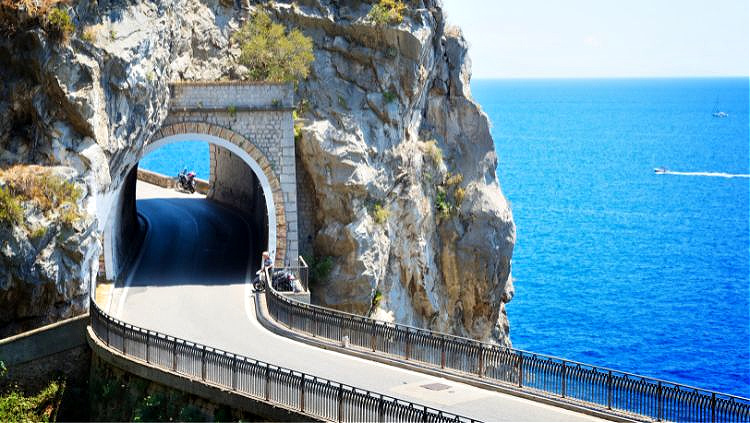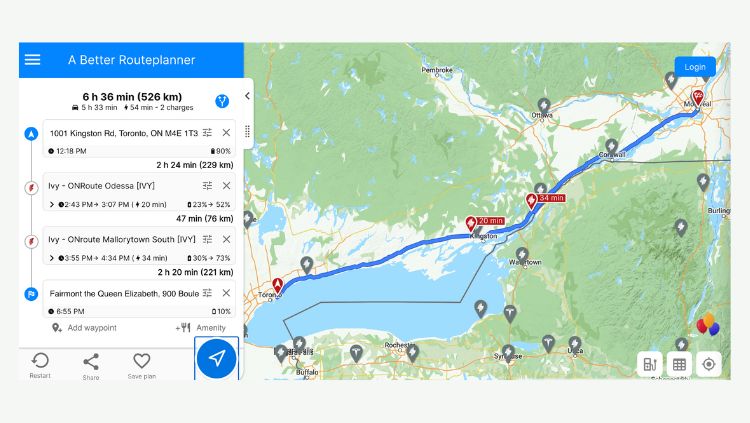
A road trip means freedom. A road trip alone gives you even more.
A solo road trip also requires you to do all the driving. It can be daunting when you start to plan and physically taxing when on the road. Not to worry. We can help with advice to relieve some of the stress. We have been helping solo travelers take to the road for years.
The benefits of a solo road trip are many. You can take any detour you want, listen to any radio station or audio book that interests you, and you can change your schedule on a whim. The list of advantages goes on. The longer the trip, the more you'll settle in to enjoy these benefits. A cross-country road trip alone is a perfect opportunity to experience the real value of being one with yourself and the road.
I've taken dozens of road trips in Canada, the US, and Europe. On these many trips I've learned a few things about how to plan, pack, navigate, stay safe, and have fun.
Once you read below about preparing for a solo road trip, check out How to Plan a Road Trip: Route Planning, Scheduling & Budgeting and these posts on specific road trips.

How to Plan a Road Trip Alone
Whether you're planning to drive across country alone or across a province or state, if long-distance driving is something you enjoy, and the idea of going your own sweet way is appealing, here’s the rest of what you need to know to prepare for a long drive by yourself.
1. Know your driving limits.
I can drive up to 10 hours in a day, but not two days in a row. Other people have a limit of three or four hours. This can be due to physical problems from sitting for that long or from pure boredom. You need to know your limits. To plan your trip, you need to know how long you can drive each day, what distance you can cover, how many breaks you need, and whether driving at night is an option. All these factors must be considered to get the road trip you want.
2. Set a theme for your solo road trip.
You might want to choose a theme for your trip. In France, it was history for me. I wanted to see the Bayeux Tapestry and also Juno Beach where the Canadians landed on D-Day. In Arizona, it was landscapes. The Grand Canyon, the Painted Desert, Monument Valley–could those landscapes from old western movies truly be real? Driving around Lake Ontario, I was visiting wineries. Every road trip I take alone has some sort of focus. Know what yours is and identify the places you just have to get to. Use this information as you plan your route.
3. Set your pace with the ideal drive and explore schedule.
Getting the pace right is a big part of a trip's success. I've found that, generally, I need three days per destination. If I have four destinations, I need twelve days. I might be able to get away with ten but it's important not to squeeze too much into too few days. If you do, you'll miss lots and find that you spend all your time driving, rather than experiencing destinations. I also don't plan to drive too far on any one day. I try to aim for five hours a day. Even though I'm not typically an early riser, I like to set out early in the morning. I'm up at 6:00 am and away by 6:30 am to beat the traffic and arrive at my destination by noon.

4. Use these tools to map your trip for navigation and points of interest.
On my trip to the American southwest I found myself using two maps. One was a map of the Four Corners by National Geographic called Trail of the Ancients. It had great information on places of interest. There are a variety of National Geographic travel maps to choose from. The other was a standard road map. In addition, I used Google Maps. I especially like road atlases for planning and recording my trip, which makes the atlas a souvenir in the end. Here's an atlas for North America and another for Europe.
5. Book your accommodation.
Now that you've mapped out your solo road trip, book your accommodation. I recommend Booking.com, though if you have a loyalty card with a specific hotel chain you may be better off booking directly with them rather than through any booking site. If you'll be RVing or camping, read Solo Camping: Tent Camping, Safety, and the RV Option.

6. Make sure you're covered.
Travel Insurance. I never travel without it – no matter what. Depending on the coverage you buy, it can reimburse the cost of doctor fees, medical examinations, medication costs, and even hotel accommodations. Possibly more importantly, it may cover the cost of getting someone you love to your bedside during a medical emergency or return you to your home if that’s necessary. For details, read A Complete Guide to Travel Insurance for Solo Travelers.
Roadside Assistance. Whether you run your battery down (as I did in Maine), lock your key in the car, get a flat tire, or worse, it's great to have roadside assistance on your side. If you have AAA or CAA, you’ll be fine in North America. If you don't have it, it's likely a good investment for a long road trip alone.
Rental Car Insurance. If you’re renting a car for your road trip (read How to Save on Car Rentals), check with your insurance company and credit cards first to find out what kind of coverage you have through them. If you rent a low-end vehicle on a credit card that offers coverage, you should be okay. If, however, you upgrade, your credit card insurance may not cover the more expensive vehicle. It's important to get the details right. If you've determined that your current coverage is not adequate for your rental car, here are the questions you need to ask the rental agency:
- How much does the coverage cost?
- What type of collision coverage is offered and what is included in this coverage?
- Who is insured under the coverage?
- Is there a deductible associated with the coverage?
- Is there anything that could possibly void the insurance coverage for the rental car?
- Is roadside assistance available as part of the coverage?
- What steps need to be taken if you get into an accident?
7. Pack right for a car trip.
Pack light. I know I say this all the time but whether you're staying at hostels, B&B's, or hotels, you are going to be hauling your luggage in and out whenever you move on to a new destination. Having just one bag to carry makes life much easier. Here's a link to my Bare Minimum Packing post for a bit of guidance on how to pack light.
8. Use multiple navigation tools to keep you on track.
Navigation when you're on the road alone can be a bit of a challenge. I use Google Maps, however, it chews through a lot of data. Depending on where you are, it could be expensive. In addition, I use the paper map or atlas I bought to plan the trip. I will also use the compass on my phone if I feel lost as it confirms my direction. It's also helpful to know that in the U.S.:
- Two-digit Interstates often go directly through cities while three-digit Interstates go around them.
- Odd-numbered highways run north to south and even-numbered ones run east to west.
9. Prepare your vehicle.
Have your car tuned up and inspected at least a week before you leave. This will give you time for any repairs that are required. Car Talk recommends the following items be checked. You can click on any of them to go to the Car Talk site for details.
- The Cooling System
- The Tires
- Steering and Suspension
- Change the Oil
- Air Conditioning System
- Check the Tranny
10. Stay in touch.
Let someone at home know your route, when you leave, and when you arrive at your destinations. A quick text message will do. If you have Wi-Fi (McDonald's and coffee shops are always good bets for free Wi-Fi), use any messenger system or send a quick email. That's all it takes.

Extra Tips for an Electric Vehicle Road Trip
Taking a road trip alone with an electric car not only gives you the freedom of the road but also freedom from the carbon footprint of a gas vehicle. While the range of travel for EVs continues to increase, there is still the issue that charging stations are not as readily available as gas stations.
1. Find Fast EV Charging Stations for Road Trips.
Not all charging stations are created equal. Fast chargers will make your road trip easier. Where to find them? Electrify America boasts a network of over 3,200 fast chargers and an additional 116 Level 2 chargers. Level 1 is to be avoided as it could take many, many hours to charge your vehicle. Also note, EVs will lose power faster in colder weather than warmer. Keep that in mind for winter road trips and be conservative in your range estimations.
2. Plan for Charging Time in Your Schedule: Apps.
You can't charge an EV in five minutes like you can with a gas vehicle. It takes time to charge and you'll need to plan for that.
A Better Route Planner is good app for this. Enter your vehicle and its year, starting and end points of your trip, and the pace you want based on the quickest way to get there, or if you prefer few but longer stops or more but shorter stops. That kind of information fits perfectly into #3 above, which is about setting your pace. You can download Electrify America's app here. Plugshare has a map of hotels with charging stations.

Increase Your Solo Road Trip Fun
1. Take the stress out of your day of driving.
Start your drive early in the morning. You'll be less tired and more alert. The roads will also have less traffic, making the drive more enjoyable. You'll arrive in daylight with time to find your accommodation if you haven't already booked it.
- When you're driving, make sure your doors are locked and (need I say this?) you're wearing your seat belt.
- Be mindful of where you park your car. Try to park near an entrance to a mall or hotel. The lot may be busy when you arrive but if it's empty when you leave you won't enjoy a long walk across a vacant parking lot.
- If your trip takes you along roads with little traffic, consider getting a full size spare tire rather than a donut tire that can only go a short distance. You can get an affordable, decent quality spare tire at a used tire store.
2. Create a playlist.
There are definitely times to listen to local radio, but chances are you'll get bored of it and, possibly, be out of range of a station. Whether your playlist includes audio books, music (you may want to get Spotify), lectures, or all three, be prepared with what will keep you happy, interested, and alert as you explore on your road trip alone. Check out our Solo Road Trip Playlist.
3. Slow down, go local.
Slow down, save on gas, and enjoy the scenery and the scene. On my trip through the southwest I listened to KGHR 91.3 Native Radio. Listening to this station, I learned what was going on in Tuba City, what the Indigenous people care about, the values they hold, and much more. It's a wonderful aspect of travel that is most easily enjoyed on a road trip. Hungry for lunch? Look for the diner in a small town and you're sure to get some local flavor from the people as well as the food. Sometimes a local museum is the one that you'll find yourself telling people about years later. Don't overlook what may appear to be small experiences as they may be the most memorable.

14 Great Road Trips: All Solo Traveler Tested
Here's a link to our road trip category. Here are 14 Great Solo Road Trips: All Solo Traveler Tested.
